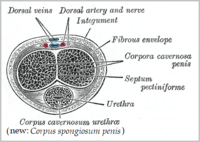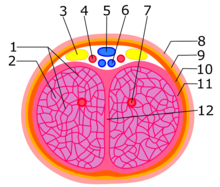Erectile tissue is tissue in the body with numerous vascular spaces, or cavernous tissue, that may become engorged with blood. However, tissue that is devoid of or otherwise lacking erectile tissue (such as the labia minora, vestibule, vagina and urethra) may also be described as engorging with blood, often with regard to sexual arousal.
In sex organs
| This section is missing information about process of stimulation and erection of the clitoris and vestibular bulbs. Please expand the section to include this information. Further details may exist on the talk page. (October 2023) |


Erectile tissue exists in external genitals such as the corpora cavernosa of the penis and their homologs in the clitoris, also called the corpora cavernosa. During penile or clitoral erection, the corpora cavernosa will become engorged with arterial blood, a process called tumescence. This may result from any of various physiological stimuli which can be internal or external. This process of stimulation, due to internal or external stimuli, is also known as sexual arousal. The corpus spongiosum is a single tubular structure located just below the corpora cavernosa in males. This may also become slightly engorged with blood, but less so than the corpora cavernosa.
In the nose
See also: Honeymoon rhinitisErectile tissue is present in the anterior part of the nasal septum and is attached to the turbinates of the nose. The nasal cycle occurs as the erectile tissue on one side of the nose congests and the other side decongests. This process is controlled by the autonomic nervous system with parasympathetic dominance being associated with congestion and sympathetic with decongestion. The time of one cycle may vary greatly between individuals, with Kahana-Zweig et al. finding a range between 15 minutes and 10.35 hours though the average was noted as 2.15 ± 1.84 hours.
Other types
Erectile tissue is also found in the urethral sponge and perineal sponge. The erection of nipples is not due to erectile tissue, but rather due to the contraction of smooth muscle under the control of the autonomic nervous system.
References
- "Erectile tissue". medical-dictionary.thefreedictionary.com. Retrieved June 28, 2012.
- ^ Yang, Claire; J. Cold, Christopher; et al. (April 2006). "Sexually responsive vascular tissue of the vulva". BJUI. 97 (4): 766–772. doi:10.1111/j.1464-410X.2005.05961.x. PMID 16536770.
- Chapter 35 in: Walter F., PhD. Boron (2003). Medical Physiology: A Cellular And Molecular Approach. Elsevier/Saunders. p. 1300. ISBN 978-1-4160-2328-9.
- ^ Kahana-Zweig, Roni (6 October 2016). "Measuring and Characterizing the Human Nasal Cycle". PLOS ONE. 11 (10). National Library of Medicine: e0162918. Bibcode:2016PLoSO..1162918K. doi:10.1371/journal.pone.0162918. PMC 5053491. PMID 27711189.
- Eccles, R (1983). "Sympathetic control of nasal erectile tissue". European Journal of Respiratory Diseases. Supplement. 128 (Pt 1): 150–154. PMID 6578066. Retrieved 14 May 2022.
This anatomy article is a stub. You can help Misplaced Pages by expanding it. |